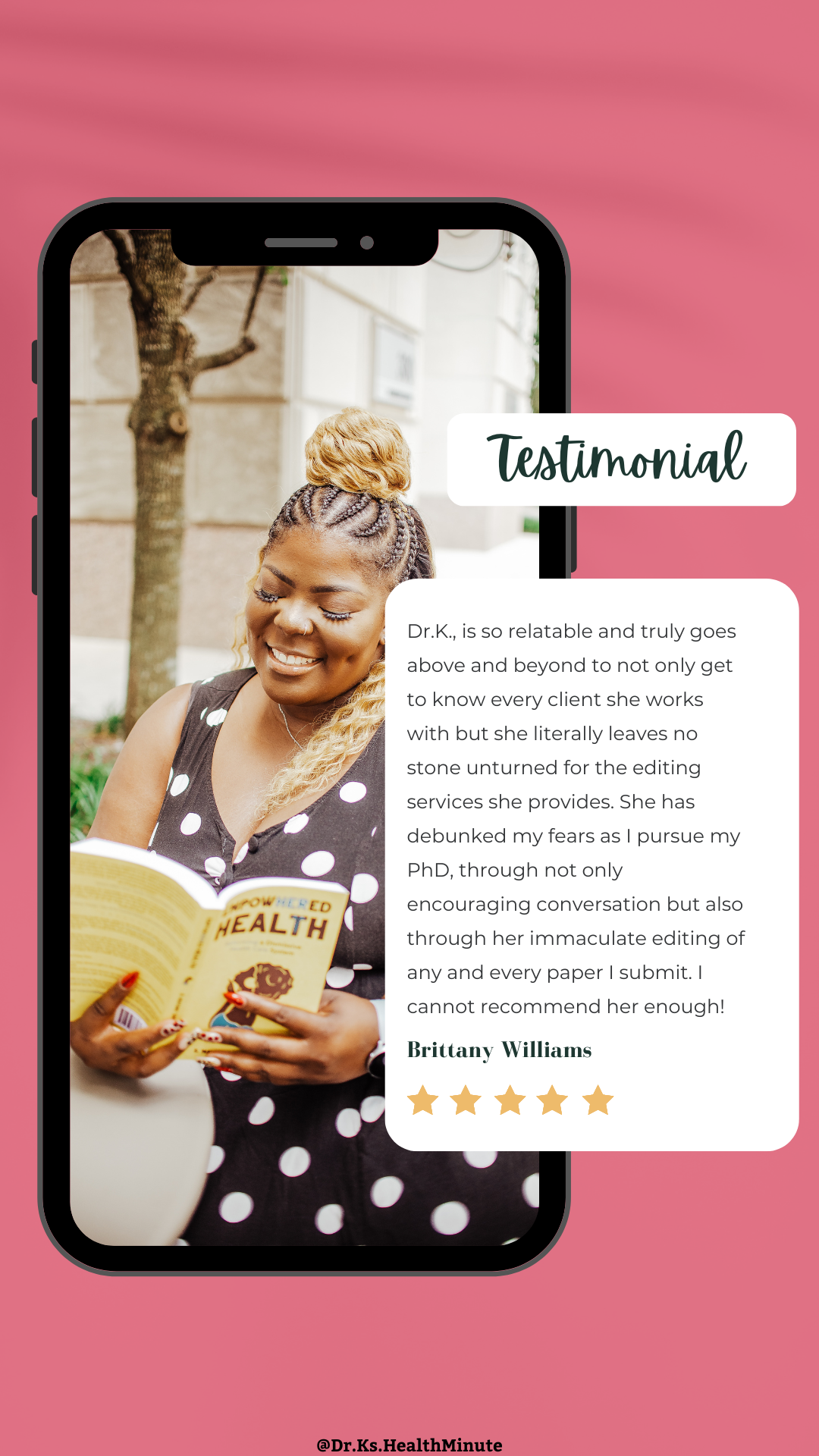



The Build: Designing Chapter 2 with Structure, Synthesis, and Flow (Digital Download)
You’ve gathered your articles.
You’ve sketched your themes.
Now Chapter 2 needs to read like a coherent argument, not a pile of summaries.
The Build: Designing Chapter 2 – Structure, Synthesis, and Flow is a digital workbook that walks you step-by-step through actually writing and refining your literature review. Created by Dr. Rahmatu “Dr. K.” Kassimu, this workbook helps you move from “I have a lot of notes” to “I have a structured, synthesized Chapter 2 that justifies my study.”
It’s the next step after The Frame, perfect for writers who have defined their scope and sources and are ready to put words on the page with intention.
What’s Inside
Across four focused sections, The Build helps you design, draft, and polish Chapter 2:
1. Blueprinting Your Chapter
Get clear on what Chapter 2 is really supposed to do—not just what goes in it.
You’ll work through tools like:
A Chapter 2 Planning Grid to map each section, its focus, key sources, and how it supports your research questions and rationale.
A visual organizer that links each major theme to your research problem, framework, and methodology.
Reflection prompts so you can explain why each section belongs and how it justifies your study, not just fills space.
2. Drafting Paragraphs with Purpose
No more “citation dumps” or rambling paragraphs.
This section teaches you how to write lit review paragraphs that actually build an argument:
A Claim → Synthesis → Takeaway worksheet so every paragraph has a clear topic sentence, integrated evidence, and a meaningful conclusion.
A Paragraph-by-Paragraph Builder that connects each paragraph to a theme, purpose, and 2–3 key sources.
A Transitions that Bridge, Not Break handout to turn choppy paragraphs into smooth, coherent flow.
3. Voice and Flow Audit
Once you have a draft, it’s time to refine how it sounds:
A Voice Audit Checklist to reduce passive voice, filler phrases, and hesitant hedging so your writing reads as confident and clear.
A Reverse Outline Tool to see the “blueprint” beneath your draft and check for logic, order, and redundancy.
Sentence smoothing techniques plus practice pages that help you cut clutter, combine choppy sentences, and tighten your language.
4. Frameworks That Flow (From Floating to Foundational)
Your conceptual or theoretical framework shouldn’t be a lonely section that never appears again.
This section helps you:
Connect your framework to the way you select, organize, and interpret your sources.
Use your framework as a lens that brings coherence to your chapter rather than an add-on paragraph.
This Workbook Is Perfect For…
Doctoral students drafting or revising Chapter 2 (especially after feedback).
Writers whose literature review feels like a “book report” instead of a synthesized argument.
Scholars in education, social sciences, public health, leadership, and related applied fields.
Anyone using The Frame to plan their lit review and now needs help actually writing and polishing it.
You’ll Walk Away With…
By the end of The Build, you will have:
A clear architecture for Chapter 2, linked to your problem, purpose, research questions, and framework.
Multiple synthesis-driven paragraphs instead of summary-only sections.
A refined scholarly voice that feels confident, readable, and aligned with your committee’s expectations.
A Chapter 2 draft (or major sections of it) that are structured, flowing, and ready for feedback.
If you’re ready for your literature review to sound as strong as your idea, The Build will help you design a Chapter 2 that is structured, synthesized, and undeniably yours.
You’ve gathered your articles.
You’ve sketched your themes.
Now Chapter 2 needs to read like a coherent argument, not a pile of summaries.
The Build: Designing Chapter 2 – Structure, Synthesis, and Flow is a digital workbook that walks you step-by-step through actually writing and refining your literature review. Created by Dr. Rahmatu “Dr. K.” Kassimu, this workbook helps you move from “I have a lot of notes” to “I have a structured, synthesized Chapter 2 that justifies my study.”
It’s the next step after The Frame, perfect for writers who have defined their scope and sources and are ready to put words on the page with intention.
What’s Inside
Across four focused sections, The Build helps you design, draft, and polish Chapter 2:
1. Blueprinting Your Chapter
Get clear on what Chapter 2 is really supposed to do—not just what goes in it.
You’ll work through tools like:
A Chapter 2 Planning Grid to map each section, its focus, key sources, and how it supports your research questions and rationale.
A visual organizer that links each major theme to your research problem, framework, and methodology.
Reflection prompts so you can explain why each section belongs and how it justifies your study, not just fills space.
2. Drafting Paragraphs with Purpose
No more “citation dumps” or rambling paragraphs.
This section teaches you how to write lit review paragraphs that actually build an argument:
A Claim → Synthesis → Takeaway worksheet so every paragraph has a clear topic sentence, integrated evidence, and a meaningful conclusion.
A Paragraph-by-Paragraph Builder that connects each paragraph to a theme, purpose, and 2–3 key sources.
A Transitions that Bridge, Not Break handout to turn choppy paragraphs into smooth, coherent flow.
3. Voice and Flow Audit
Once you have a draft, it’s time to refine how it sounds:
A Voice Audit Checklist to reduce passive voice, filler phrases, and hesitant hedging so your writing reads as confident and clear.
A Reverse Outline Tool to see the “blueprint” beneath your draft and check for logic, order, and redundancy.
Sentence smoothing techniques plus practice pages that help you cut clutter, combine choppy sentences, and tighten your language.
4. Frameworks That Flow (From Floating to Foundational)
Your conceptual or theoretical framework shouldn’t be a lonely section that never appears again.
This section helps you:
Connect your framework to the way you select, organize, and interpret your sources.
Use your framework as a lens that brings coherence to your chapter rather than an add-on paragraph.
This Workbook Is Perfect For…
Doctoral students drafting or revising Chapter 2 (especially after feedback).
Writers whose literature review feels like a “book report” instead of a synthesized argument.
Scholars in education, social sciences, public health, leadership, and related applied fields.
Anyone using The Frame to plan their lit review and now needs help actually writing and polishing it.
You’ll Walk Away With…
By the end of The Build, you will have:
A clear architecture for Chapter 2, linked to your problem, purpose, research questions, and framework.
Multiple synthesis-driven paragraphs instead of summary-only sections.
A refined scholarly voice that feels confident, readable, and aligned with your committee’s expectations.
A Chapter 2 draft (or major sections of it) that are structured, flowing, and ready for feedback.
If you’re ready for your literature review to sound as strong as your idea, The Build will help you design a Chapter 2 that is structured, synthesized, and undeniably yours.
Format & Delivery
Type: Digital workbook (PDF)
Length: ~30+ pages of guided tools, templates, and practice pages TheBuildWorkbook
Delivery: Instant download after purchase
Use: For personal use only; you may print or annotate digitally as you build your dissertation
How to Use
Pair The Build with The Frame: use The Frame to define your scope, sources, and themes, then use The Build to write and refine Chapter 2.
Work through one section at a time while drafting your lit review.
Revisit the planning grid, paragraph builder, and voice audit whenever you get stuck or receive new feedback.




















